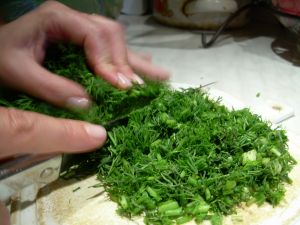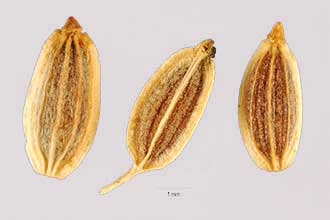Dill Characteristics
(Anethum graveolens, Linn.)

Name Origin:
The plant is referred to in Matthew xxiii, 23, as “Anethon” which for generations was incorrectly translated to anise. The name dill is derived from the old Norse word, dilla which means to lull and refers to the herbs ability to sooth the stomach.
Natural Order:
Apiaceæ
Growing Cycle:
Hardy annual
Origins:
A native of the Mediterranean and Black Sea regions with some archeological evidence in Switzerland dating to the Neolithic period.
Height:
Dill grows to 24-30 inches tall
Growth Habit:
Similar in appearance to fennel but with slightly broader leaves that resemble short, threadlike pine needles.
Dill Flowers:
Compound umbels with numerous yellow flowers, the petals of which are rolled inward.
How to Grow Dill and Dill Weed
(Seeds, sowing, cultivation, and harvesting)
Growing Dill From Seeds

Dill seeds remain viable for 3 years under fair storage conditions. An ounce of dill seeds contains over 25,000 seeds. Don’t need 25,000 dill seeds? Maybe this pack of Bouquet Dill Herb 500 Seeds are a better option.
Before growing dill, be prepared to be pro-active once the seeds have formed. Left to their own devices, your dill plants can easily overrun your garden. Dill makes a great companion plant but there are a number of garden plants that should not be planted nearby. Please visit our Dill Companion Planting Guide before planting dill in your garden.
Dill is a crop best rotated in the garden. When growing dill from seeds, sow the seeds in early spring, preferably in warm sandy soil, where the plants are to remain. Sandy soil is preferred but any well-draining soil will do. Some growers do prefer fall sowing, claiming the seed has higher germination rates and produces better plants.
Make the drills 1 foot apart and scatter the seeds thinly and cover lightly, with no more than 1/4 inch of soil.
Dill is something of a cold weather crop and will tend to bolt quickly during the warmer months. Sow seeds throughout the season to ensure a continual harvest.
Cultivation
Keep dill plants free from weeds and the soil loose and open. Thin seedlings to 9-12 inches apart. Dill plants do not like being disturbed therefore transplantation is not recommended.
Harvesting Dill
Dill plants provide two distinct crops – leaves and seeds.
Leaves, usually referred to as dill weed can be harvested once the plant is fairly established. Experts recommend not harvesting any more than 1/3 of the plant at one time. While pruning dill does encourage new leaf growth it ultimately shortens the lifespan of the plant.
If you plan on growing dill for its seeds, harvest seeds around mid-summer when the seed is ripe, carefully gather and cut the stalks. Quickly place the dill cuttings into paper bag to limit seed loss and prevent volunteer seedlings. Let the seed heads dry completely and separate the stems and other debris from the dill seeds. Store your dill seeds in a paper envelope.
Culinary and Other Uses of Dill & Dill Weed
(seeds, dill vinegar, dill oil, and early foliage)
Dill Seeds
The seeds are often used in soups, sauces, and stews. They are most commonly used with pickles and are a main ingredient in German recipes for preserving cucumbers.
Dill Vinegar
Soak seed in good vinegar for several days. The vinegar will absorb only a certain amount of the flavor and seeds may be removed and reused to create a slightly weaker infusion. The two infusions are often then mixed and stored in a dark cupboard for use as needed.
Dill Oil
Often used to perfume soap. Essential Dill Oil is also said to help curb sugar cravings. Haven’t tried it myself, but there are some who swear by it.
Young Leaves
Used in pickles, soups, sauces and often as an ingredient in cold salads.
Dill from the grocer’s shelf will often contain dried, young leaves.